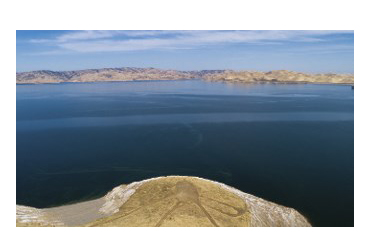September 25, 2019 - By Kevin Hecteman - As water years go, 2019 was all wet. With the new water year beginning Oct. 1, farmers and forecasters hope for more of the same. (Left) San Luis Reservoir held more than 1.4 million acre-feet of water when this photo was taken in late May. Last week, it held about 1.2 million acre-feet, 134% of average for the date. Photo/Ken James, DWR
(Left) San Luis Reservoir held more than 1.4 million acre-feet of water when this photo was taken in late May. Last week, it held about 1.2 million acre-feet, 134% of average for the date. Photo/Ken James, DWR
Tulare County farmer Zack Stuller described 2019 as a "fantastic year" for water.
"The reservoirs are a lot fuller than they've been in the past," Stuller said. "It looks very promising."
The data support that view. A California Department of Water Resources storage summary showed all but three of the listed reservoirs running at or above their historical average as the water year nears its end. Shasta Lake stood at 125% of average, for example, while Oroville showed 106%. The three reservoirs under 100%—Beardsley, Success and Cachuma—were running 93% to 96% of average.
Though it swelled reservoirs, the wet year did not provide full water supplies for all. Customers of the State Water Project and south-of-delta agricultural water contractors of the federal Central Valley Project had 75% supplies.
In announcing the final allocation in June, the U.S. Bureau of Reclamation, which operates the CVP, cited "regulatory restrictions" such as requirements for protected species as the reason for the less-than-full supply.
With that in mind, California Farm Bureau Federation Senior Counsel Chris Scheuring said the strong 2019 water year should not distract from "the public-policy issues that never go away in California water."
Scheuring said he thinks water deliveries may remain good for the next year or two, but farmers should be prepared for another multiyear drought.
"One concern would be, of course, that even though many of our reservoirs are in good shape because of the last year, that if we have another good rain year this year—which we hope we do—there may be some water there that has to be bypassed because the reservoirs are already too full," Scheuring said. "And that's a shame. We want to have as much reservoir capacity as possible, ultimately, both above ground and below ground."
Predicting the 2020 water year remains a coin flip. So far, the National Weather Service foresees even chances of a wet, dry or neutral year, said Chris Orrock, a DWR public information officer.
"The only constant for weather in California is how unpredictable it is," Orrock said. "We go from one extreme to another."
This year, for example, "almost all of the major atmospheric rivers were met by cold-weather systems that came down from the Gulf of Alaska," he said. "So these warm, heavily laden water systems contacted this cold weather and put a lot of snow up in our mountain ranges."
Though the resulting snowpack didn't set records, it did provide steady snowmelt into July, Orrock said.
"The long melt of the snow over the summer continued to have water in our reservoirs, which is good for the start of next water year," he said, adding that the high carryover storage "also means that Californians have really changed their water habits and are starting to conserve more."
Stuller, who grows citrus, stone fruit, kiwifruit and walnuts, said he thinks water districts have been conservative, holding back as much as possible to assure another good water year, "which I appreciate."
Orrock noted that the three components of California water storage include reservoirs and other surface storage; snowpack; and underground storage. The last is the subject of the 2014 Sustainable Groundwater Management Act; Scheuring noted the first groundwater sustainability plans required by SGMA are coming in and being evaluated.
"It's everything," said Stuller, who farms in affected groundwater basins in Tulare and Fresno counties. "We're in ground zero."
"It's scary, but hey, from a guy that believes in sustainable farming—and you know, I want to be here multigenerational—it's necessary," he said. "We either need more surface water, or we've got to start pumping less, or we've got to farm less. I mean, it's those options."
Stuller said he favors development of dams or recharge basins.
"Any project that could add water to our valley or the state, I think, is totally beneficial," he said, but added there's "a lot of red tape, a lot of hurdles, a lot of money" involved.
A key factor in operation of the existing water system will be the outcome of voluntary settlement negotiations involving water flows from the Sacramento and San Joaquin river systems to the delta.
Scheuring noted that one of Gov. Gavin Newsom's stated reasons for pledging to veto Senate Bill 1, which would have preserved existing California environmental and labor standards from federal changes initiated by the Trump administration, was to avoid jeopardizing those negotiations.
"We would certainly like to see the voluntary agreements come together in the right way for the water users that are affected, because ultimately that whole process could be a template for a lot of rivers in the state of California," Scheuring said.
Snow surveys for the 2020 water year should begin in December, depending on snow location, Orrock said.
Slated to join the effort, contingent on funding, will be the Airborne Snow Observatory, a joint venture of DWR and the NASA Jet Propulsion Laboratory.
A survey plane will operate from the Bishop area, Orrock said, and will be capable of measuring larger areas, especially those inaccessible to snow-survey teams, at higher elevations using lidar and radar. A state bill directing funding to the project, SB 487, has cleared the Legislature and awaits action from the governor.
(Kevin Hecteman is an assistant editor of Ag Alert. He may be contacted at khecteman@cfbf.com.)
Reprinted with permission: California Farm Bureau Federation








